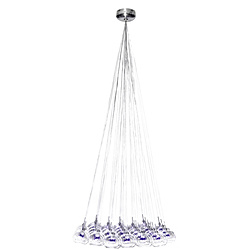 Access Lighting
Access Lighting Vienna Chandelier 23967 $810.00


The most common lighting is a bath bar over a mirror, the bar should be shorter than the mirror by a few inches on either side. Sconces on both sides of the mirror will even out the lighting which is ideal for makeup application, shaving and other tasks where you need to see small details. The best option is a combination of both an over head light, like a bath bar and sconces, that will give you the most even lighting! A newer trend is to use pendants in place of the sconces, or to add drama by using mini chandeliers! A light over the vanity usually is not enough light for the whole room, a flush mount is very common for this space, it is really nice if you can put the over head light on a dimmer so you can soften the light if you desire!

Pendants can be used everywhere! The most common places for pendants are over a table, island or bar in a kitchen or dining room setting. Pendants have become more and more popular for vanity lighting in bathrooms and over night stands in the bedroom. A good rule to follow is always placing a fixture so the bottom hangs 30-34 inches over the surface you are illuminating. As always there are exceptions to the rule! For task lighting you really want to avoid shadows, and to make sure you have a nice even lighting to make sure we get that even light we use photo metrics. You want to create lighting that overlaps and gives a smooth even bright lighting so you can see to accomplish any task at hand!
 This Photometric chart shows how much area will be illuminated when it is a certain distance away from the light source. For example if you are hanging a pendant over a bar and the bottom of the pendant sits 2 feet from the top of the bar you will only get 1 foot in diameter of light from that pendant. (There are some extra limitations like the shape of the glass (like I said there are always exceptions to the rule) but this chart helps determine how high you want to hang a pendant.) So you would have to hang a lot of pendants to create that even lighting if you want them to sit 2 feet above the bar. If you hang them closer to 4 feet from the surface you will get a wider beam of light and you can use fewer pendants to illuminate your work space.
This Photometric chart shows how much area will be illuminated when it is a certain distance away from the light source. For example if you are hanging a pendant over a bar and the bottom of the pendant sits 2 feet from the top of the bar you will only get 1 foot in diameter of light from that pendant. (There are some extra limitations like the shape of the glass (like I said there are always exceptions to the rule) but this chart helps determine how high you want to hang a pendant.) So you would have to hang a lot of pendants to create that even lighting if you want them to sit 2 feet above the bar. If you hang them closer to 4 feet from the surface you will get a wider beam of light and you can use fewer pendants to illuminate your work space.
 OUTDOOR LANTERNS
OUTDOOR LANTERNS

 FOYER
FOYER

 Thomas Edison
Thomas Edison
Many are familiar with florescent lighting, or compact florescent lights. The compact florescent, CFL, lights have become more and more of a standard issue in homes around the country. They can replace all standard light bulbs and many of the bulbs you use in recessed cans. The CFL bulb that replaces the 60 watt incandescent bulb only uses 13 watts of energy while giving a light output that is equivalent to 60 watts. CFL bulbs can last up to 10,000 hours a whole ten times longer than the standard incandescent bulb. Keep in mind the incandescent bulb has not changed much since Thomas Edison invented it in 1879.


 LED Bulbs
LED Bulbs
Light-emitting diode, or LED, is energy efficient lighting, and in my experience is one of the most requested types of lighting currently available.
Incandescent lighting which is the most common type of lighting in residential homes is the cheapest to buy and the most expensive to operate. LED which is one of the more expensive types of lighting on the market is much cheaper to operate. The average life span of an incandescent light bulb averages around 1,500 hours, where as the LED can last up to 50,000 hours. Though the initial cost of the bulb is higher it is likely you will not need to replace the bulb for at least 8 years, and the energy used is significantly lower, keeping you home energy cost way down. Over the long run a LED is much cheaper than an incandescent bulb!
By merely changing a light bulb in an existing fixture we can really cut down on our energy usage and make a big difference in the environment. While CFL replacements are a good option they have their flaws. Many do not like the color that a CFL puts out. Many of us are so accustomed to the soft yellow glow from



I love pendants and I am not a lone! Pendants are a great way to spice up a room; they really are a hanging piece of art. Tech lighting, see pictures above, uses murano glass hand blown in
Tech is one of the many vendors who make pendants, LBL, Nora, WAC, Besa, and our newest vendor Bruck all make line and low voltage pendants.